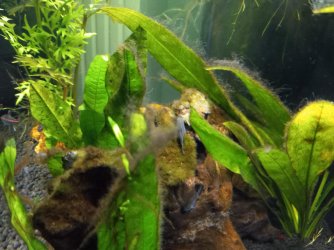Hello, asking for suggestions to deal with what I think is black beard algae in my 15-gal (Fluval Flex) planted tank, primarily on the plants. It has been up and running for about 3 months now with stable parameters (see below). I have been "scraping" some off of the leaves between my fingers, but it grows back quickly. I don't have an algae eater per se, as I don't know of one that would do well in this small tank, but do have 3 spotted Corys, 4 Pigmy Corys, and 6 Red Cherry Shrimp. (Also, for a complete stocking description, there are 6 Glow Light Tetras and one Dwarf Gourami).
I DID have a fairly large pest snail population, which no longer exists after adding two assasin Snails. With the pest snails gone, the algae growth is getting worse.
I can easily just replace the plants, but I assume the algae growth will return.
Appreciate any input you may have.
Parameters:
pH 7.0
KH 40
GH 107
Ammonia 0
Nitrite 0
Nitrate 0-20
5-gal (33%) water changes weekly
no chems or charcoal used
plant food - Thrive-S 3x per week
I DID have a fairly large pest snail population, which no longer exists after adding two assasin Snails. With the pest snails gone, the algae growth is getting worse.
I can easily just replace the plants, but I assume the algae growth will return.
Appreciate any input you may have.
Parameters:
pH 7.0
KH 40
GH 107
Ammonia 0
Nitrite 0
Nitrate 0-20
5-gal (33%) water changes weekly
no chems or charcoal used
plant food - Thrive-S 3x per week




